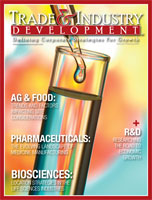The Bio Revolution
In this edition of Trade & Industry Development we take a look at those industries related to the biosciences. From agriculture and food processing to pharmaceuticals and life sciences, we examine the lay of the land, the latest developments and the trends going forward. Speaking of recent developments in this arena, two stand out that occurred this year, just months apart. On May 20th, scientists at the J. Craig Venter Institute (JCVI) announced that they had created the first self-replicating synthetic bacterial cell. Just over six months later, in early December, a NASA astrobiologist announced that a microbe had been discovered at Mono Lake in California that can live and grow utilizing a toxic chemical - arsenic (although this discovery is still the topic of some scientific debate). Our very definitions of life have just shifted, and opened doors to possibility that imagination has yet to fully step through. And it is worth noting that both of these discoveries took place in the United States. JCVI is a private research organization headquartered in Rockville, Maryland, and NASA, our excellent space program, has produced many breakthroughs for the world.
In our feature on siting Bioscience and Life Science companies, Larry Moretti and Andy Shapiro explore current trends in these fields and offer significant advice for choosing the right location for expansions based on a company's needs and strategic goals. In his excellent article on Food Processing and Agriculture, Bob Price examines factors impacting these industries and weighs life-cycle considerations as they relate to suitable facility locations. And Tim Smith focuses on the locational considerations for Pharmaceutical and Nutraceutical companies. Also, Jennifer Alten provides an intriguing glimpse into some communities and companies throughout North America which are focused on Research and Development, and Linda Dobel takes a look at the various kinds of business parks making an economic difference. In addition, James Greenwood of the Biotechnology Industry Organization (BIO), the world's largest biotechnology organization, provides a snapshot of the biotech industry and the policy considerations needed to keep this vital sector growing.

